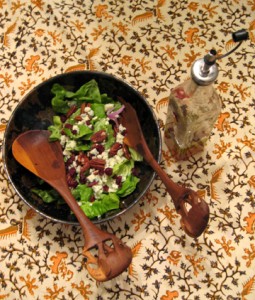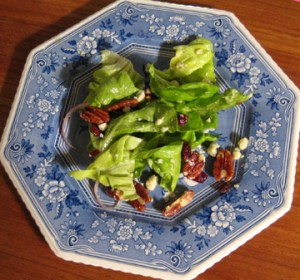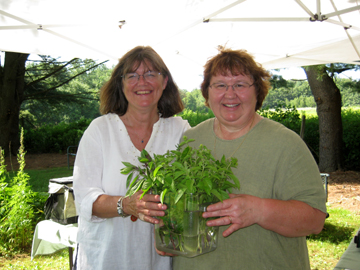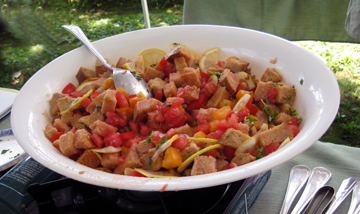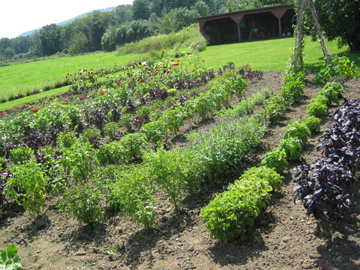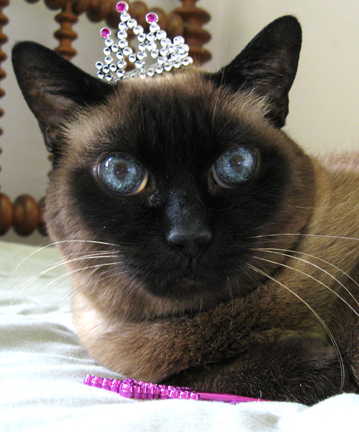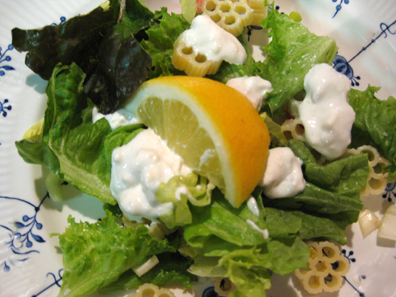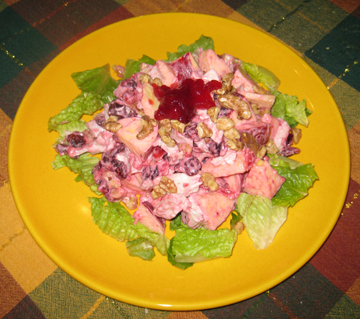
It has taken me several days to recover from the digestive excesses of Thanksgiving. I went to the store yesterday to buy milk and turned a little green when I saw the cream lurking on the shelf nearby.
So I have vowed to work on simple foods–salads in particular–to get my palate and waist back into line before the latkes and Christmas cookies start flying around.
The trouble with this strategy is that there are still plenty of leftovers from Thanksgiving in the house. I don’t have any trouble avoiding the desserts (most of them are in the freezer at this point anyway), but I can’t really ignore the turkey.
A couple of days ago I decided to throw some turkey and cranberry sauce into a Waldorf Salad.
I love Waldorf Salads. Actually, I love the Waldorf-Astoria Hotel, period–the chic art-deco trim, the Bauman rare-book display in the lobby, Cole Porter’s piano (surely the classiest musical instrument in the world!), the charming waiters and receptionists.
My friend Chikako was married there many years ago. When she explained that according to Japanese custom school friends of the bride always sing at weddings I crooned “Let’s Call the Whole Thing Off” with the band. (It was the only song they and I knew in common.)
Ever since then I have dreamed of calling my autobiography I Sang at the Waldorf.
I also like the Waldorf’s long culinary history, particularly the legend of maître d’hôtel Oscar Tschirky, who worked at the hotel from its opening in 1893 until 1943.
Oscar of the Waldorf, as he was called (perhaps I should rename my book Tinky of the Waldorf?) created the Waldorf Salad, Veal Oscar, and (according to some sources) Eggs Benedict. He also introduced Thousand-Island Dressing to a wider eatership.
He was known for his flair with food and with people. When asked for a testimonial to accompany his application at the Waldorf, he allegedly walked around Delmonico’s Restaurant (his previous workplace) asking his favorite customers to sign the glowing letter of recommendation he himself had written.
The signatures–supposedly from such luminaries as entertainer Lillian Russell, businessman/gourmand Diamond Jim Brady, and railroad executive George Jay Gould–did the trick, and Oscar Tschirky became Oscar of the Waldorf.
A delightful 1931 profile called “Oscar the Epicure” enthused, “Whenever people, in America at least, speak of the art of eating, they invariably mention Oscar.”
The profile appeared in a book by Edward Hungerford (published by G.P. Putnam’s Sons) titled The Story of the Waldorf-Astoria. (The first edition was published in 1925; I don’t know whether the 1931 edition was identical or not.) You may read more of the profile and the book on either of these wonderful web sites: Old and Sold and Boldt Castle.
Oscar believed in the craft of menu construction and amassed an extensive menu collection, which he left to Cornell University’s School of Hotel Administration along with his personal papers.
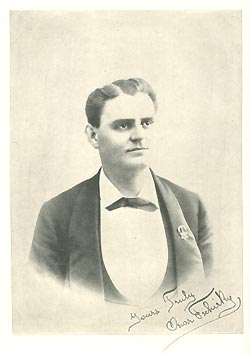
I feel that I have a tenuous connection to Oscar Tschirky through my brother David, who frequently sojourns at the Waldorf on business. We actually often refer to David in the family as “Mr. Waldorf-Astoria.”
The nickname is a tribute not to his connection to the hotel but to his extravagant tastes. My Great-Aunt Charlotte used to call my grandfather the same thing because she thought he had rather “la dee da” ways. (He did, but we loved him anyway–and we love my brother.)
I could write a lot more about Oscar and David and the Waldorf, but this essay has already meandered on longer than a blog post is supposed to. So let me return to the topic of my turkey–or rather Tschirky–salad.
A Waldorf Salad has many virtues. It’s a cinch to throw together. It uses fresh ingredients one has on hand for much of the year. And it illustrates some of the properties that make those ingredients so wonderful.
Apples, celery, and walnuts are crunchy foods. It’s only when eating them together in a salad, however, that one realizes that they’re crunchy in different but complementary ways.
My Thanksgiving salad (also a great idea for Christmas!) adds the softness of turkey and the rich red hue of cranberry sauce to this classic dish. I have to admit that the color of the mixture startled me a bit. It’s a very mid-20th century shade of pink.
I’ve always been one to embrace garishness, however. Oscar of the Waldorf had a flamboyant side. Why shouldn’t I?
You’re the top. You’re a Waldorf salad.
You’re the top. You’re a Berlin ballad……..
Garish Thanksgiving Salad from Tinky of the Waldorf
Ingredients:
1/4 cup mayonnaise (low-fat is fine)
2 tablespoons whole-berry cranberry sauce plus a bit more later
the juice of 1/2 small lemon
1/2 teaspoon salt
1 firm apple (I used a gala), cored but not peeled, cut into bite-size chunks
1/2 cup walnut pieces, toasted for a few minutes in a small cast-iron pan (toss while doing this!) to release the oils
2 stalks celery, cut up
1/3 cup dried cranberries (you may use raisins, but these extend the holiday theme)
3/4 cup pieces of leftover turkey meat
lettuce as needed
Instructions:
In a bowl combine the mayonnaise, the 2 tablespoons cranberry sauce, the salt, and half of the lemon juice.
Sprinkle the rest of the lemon juice on the apple pieces and toss gently.
In a larger bowl combine the apple pieces, most of the nuts (save out just a tablespoon or so), the celery, the cranberries, and the turkey. Add the mayonnaise mixture and stir until everything is a bit pink.
Line a serving plate or bowl with a bed of lettuce, and place the salad on top.
Sprinkle the remaining nuts on the top, and put just a dab of additional cranberry sauce smack in the middle (because you need EVEN MORE COLOR!).
Serves 2 generously.
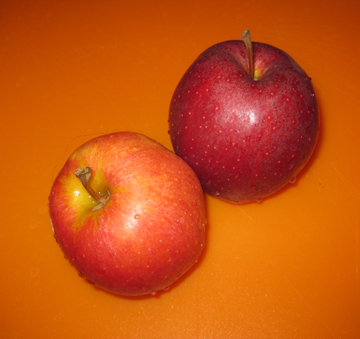
If you enjoyed this post, please consider taking out an email subscription to my blog. Just click on the link below!
Subscribe to In Our Grandmothers’ Kitchens by Email.



